(Only my) Music to my ears
Oh no!! This is becoming more convoluted that I ever expected. It was meant to be about a jolly little elephant and its trunk, but with its developing it grew very very complicated and multi-layered.
So, “Only my music to my ears”! Is it good or bad? Oh, it depends (as usual). This cutout looks benign, but it became loaded with a political and moral content and context. However, let’s start with something innocuous. Like elephants and trumpets. Who is not fascinated by elephants?! The biggest creatures of our world, majestic, huge, but benign (mostly), super strong but sensitive and emotional, super intelligent but caring (if these need to be self-excluding), herbivore, which is the ancient word for vegetarian, and peace lovers. Remnants of the worlds passed away, of mammoths, likely of dinosaurs and who knows of whom else.
They are equipped by nature with the funniest nose of all, which also serves as a hand, the proboscis, that is the trunk
I remember, at the age of six, or eight, I was taken by our grandfather to Kraków Zoo, and as it was in the rustic 1952-53s you were still able in the Zoo to touch benign animals, like elephants, so I was astounded and enchanted by the softness of the touch of the elephant trunk tip, or in fact, of the appendage they have there and use as fingers. Since then, I was in love with elephants and their trunks. In Roman culture languages the elephant trunk goes by la tromba (in Italian), la trompe (in French, Portuguese, Romanian), la trompeta (in Spanish), trąba (in Polish), which is for obvious reasons the same word as for a trumpet or any of the brass instruments. Therefore, for me the elephant tromba is a built-in musical instrument that these animals are naturally equipped with. So, without dragging you too deep into this increasingly complicated metaphor, this is how I see it: like elephants, one should (and could) provide the best suited music for oneself.
Now, that brings us back to the initial question: Is it good or bad?
Like many people, I am sure, I continue to wander how on earth within less than seven or so years, decent societies that for decades have lived in a relative internal harmony became divided into two fiercely and hostile opposing political groups. The division is all-consuming and transcends political sphere and infects social and family life.
This happened recently in “my” two countries: US and Poland, but is seen also in places such as Brazil, Hungary and Slovakia. I do not include here Russia as this is a post-communist remnant society, an anomaly per se. And certainly, it’s not an unheard-of-phenomenon. As we all know, it starts with an emergence of a (self-propelled) political leader that initially is not very clearly ideologically defined, but very quickly starts tilting to the right, with a growing backing from dominating religious organizations. Such leaders often wage an extremely aggressive political and electoral campaign breaking limits of decency, truthfulness, and vulgarity, not to mention elegance and a good taste. With an incendiary populistic rhetoric and promises they attract faithful crowds of thousands. And the tone and the essence of the campaign often blatantly goes against the very teaching of the religions that stunningly support those leaders. The political leaning and the church support though appear not to be essential but helpful components, in view of historical experience which yielded hitlerism or stalinism, or Italian fascism (Lenin on L., Mussolini on R, with crowds “the likes of which nobody have ever been seen before”) .
Lenin speaking in Moscow, 1920 Mussolini speaking in Rome, date unknown
So, the phenomenon of polarization of societies is nothing but new, historically, but it is new to our personal experience, and it brings pain as it affects friendships and family ties. It pains to realize that people that you love, most strongly support the position that you most strongly oppose. How it could have happened that we grew so much apart? And why?
The how, is easy. Just analyze how those leaders proceeded, incrementally. This is a biblical prescription for creation. You tried something, and you saw it was good, so you expand it and proceeded to the next step. The steps may be: the choice of a right-wing inclination, the appeal to the marginalized masses of not-have ones, easy to manipulate, and then, the cleverest trick: informational isolation. Formation of polarized information poles, where the opposite views are first marginalized, then ridiculed, then gradually eliminated, and condemned. As a result, your audience listens only to you, your narrative and any other standpoint is deemed a fake, false, wrong and dangerous attack on your leader’s teaching. Then your leader needs you to provide an uncompromised defense. Any dissensus is a treason. Only your music to your ears!
And then there is The Why. It appears to me to be a confluence of two forces: a self-motivated leader in search for a flock to lead, no matter what’s its denomination, and a needy flock in a search of a leadership. The mechanism is always the same: identify a group of disappointed people, and self-proclaim yourself to be their voice. Such were the masses of starving Russian Tsar soldiers loosing on the battlefield in 1917, Germans that felt humiliated by the Versailles Treaty and then run down by the 1928 financial crush and Great Depression, the Americans failing to recover from the Great Recession of 2007-9, the Poles and other East Europeans that lost on the economic transformation after the elimination of the communist regimes in 1990s, the Russian masses struggling in a hopelessness of Putinesque stagnation and political oppression. And always, nearly physiologically unhappy class of retirees everywhere.
The unhappiness and anger of such masses was ignored by the tone-deaf dominating political forces of the moment and skillfully and ruthlessly taken advantage of by emerging unscrupulous leaders promising representation, revenge and retribution. Those leaders provided purpose and hope and a sense of belonging to the “forgotten” masses. Especially the latter one, this sense of belonging, is what has personally attached those masses to their leader swso fanatically. This pops up in many interviews with MAGA followers.
The tone-deafness of the political and social elites to the misery and hopelessness of some segment of the society is what leads those segments of the society to seek and find an easy solution for their problems in the populist movements. That tone-deafness is equivalent not listening to “other” musics. While it can be forgiven in the strictly musical context, it is a mortal sin in politics and social engineering.
So, being limited to listening to your own music only is not advisable.
But there are at least two other sides of that multidimensional coin! First, listening of only your own music creates a wonderfully cozy comfort zone, both in musical and political terms. And that practice attracts many followers. Second, listening to the music of “others” requires patience and good will. From my personal musical experience, I know that a piece that at first time sounds strange, not to say unpleasant, but after a few encores it gradually becomes much more convincing, or maybe even pleasant. There may be not much room for pleasure in politics, but for a more far-sighted player there may be a substantial political payoff, when they truly listen to “the other side”, or to be more charitable, a considerable social benefit. Morale: learn to listen to a music that may not necessarily sound “yours”, as in this cutout, music of that bird up a tree as well. Uff !!! That had to be said. Now, back to real music and the elephants!
Musical symbolics in paintings is as old as painting itself. Already in the cave paintings that go beyond 35 000 years back there were figures of people playing flute (sort of). A series of the attached images below are from American West petroglyphs, of Anasazi culture, seems of today’s Hopi Indians, now submerged in Lake Mead, after construction of Glen Canyon Dam in 1960s. The images were copied then, and now are available online in a huge variety of AI generated “replicas”. Two on the left seem to be authentical, while that on the right is a “desexualized” widely commercialized version of a flute player known under a name Kokopelli.
In times of ancient Greece, music was awarded its own Goddess, named Euterpe, deemed an “inventor” of musical instruments, shown below in a fresco at a Pompei house.
Trumpet is also a primordial invention. First ones were natural instruments made of animal horns or sea-shells used from neolithic times to emit one or two tones or to amplify an announcer speech (see the Greek salpinx player clay figurine), or to send a military command (see the Greek warrior image). Very early, as reported as early as in 3000 BC in the Sumerian clay tablet writings there were many instruments, string, wind or drum, in use. They soon became present in the visual art works, see again a Roman fresco, or instruments became richly decorated objets d’art, as the Australian didgeridoo (below).
In the renaissance periods music is well represented, from the early three singing monks in an English manuscript, dated c. 1310–c. 1320, with a motet, Zelo tui langueo, as in a decorated initial C for Psalm 97 of the Psalter of Queen Philippa (L); and in Piero della Francesca, Nativity, 1470 (R).
Trumpeters of the court in a fresco “June” in Torre Aquila of Castello Buonconsiglio, Trento, Italy, unknown painters, 1391-1407
Returning to elephants, I am certainly not the first one to equip them with a trumpet in an artistic imagery. One, contemporary ink drawing by a Belgian artist Madame Memento attracted my attention by its closeness to my own vision.
Illustration made by Madame Memento. Trumpet player elephant in black and white. The background was created using pages from an antique French Magazine, La Petite Illustration, from around 1910. There are numerous other similar examples of photoshop works and collages:
Surreal Music, by Mario African Sonata, by Vladimir Kush
Elephants, per se were objects of fascination and fantasy for long. Were well known to literati for ages from the historical recounts of the Hannibal army march and victory, but not much seen, actually. So, like with famous image of rhinoceros by Dürer, which he has drawn based on third hand descriptions, elephants, known also as oliphants (old French term) were drawn based on snippets of description, travelers’ tales and fantasy. A bit like a huge dog, a horse, or a pig?
Albrecht Dürer, Rhino, 1515
Imaginary medieval elephants
Medieval elephant as a precursor of a vacum cleaner Medieval elephant with nefarious intention
( Bestiaires du Moyen age by Pastoureau )
Salvador Dali, 1948, The elephants
It has been my habit to share the path of the development of the idea for a cutout from the beginning, through technicalities to the final product, and I am faithful to this practice. As usual in my case, the first idea is purely mental, no drawings, no sketches, just imagination and a visual memory of a non-existing image, thought out and modified and improved, all in the imaginary space. This is at this stage when I look for historical associations, compositional cheat sheets, real life photos, additional inspirations. Once the vision in my mind is sufficiently acceptable and growing exciting, I start with paper sketches, however preliminary and incomplete. Here are two of such:
Then there is still more looking and contemplating, and at some point, when fed up with all that, I make a drawing on metal. So, here the proportions are set, the anatomy and dynamic of the dancing elephant is already at its best, and then the cutting starts. Mind you, nothing is final, many things can change, until a cut is made. A cut is irreversible. If a mistake is made, you have to live with it. The beauty of my art (to me) is that as being non-professional, or art-brute, or outsider art, the mistakes and imperfections or wrong cuts are part of the charm, i.e. art.
So many times, at an advanced stage, like the one below, I concluded that a detail should be simplified, or just thrown out, … or added on a whim, like the Mickey-Rodent showing up at the right bottom corner in the final version.
So, finally this is what you get. Colors (sprayed) are rather soft and atmospheric, except when you want them to shout. With the lighting changing from behind and/or from the front, colors play differently during the day light and the night.
Enjoy !!
Amen !




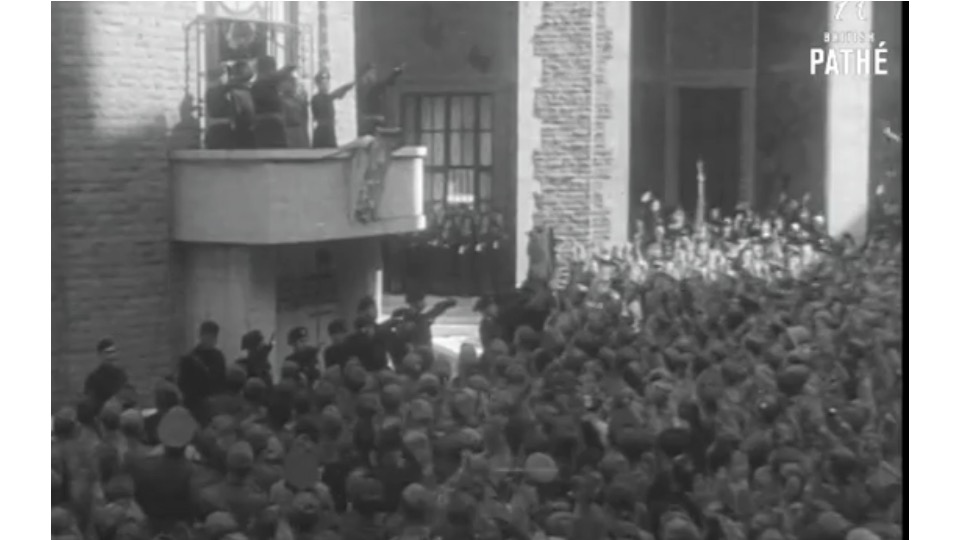






 Pompeian fresco
Pompeian fresco















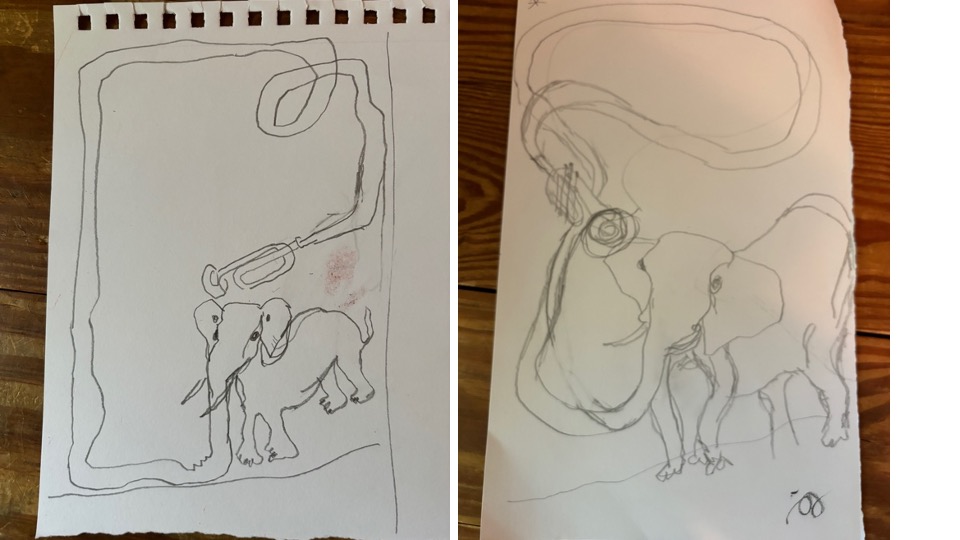
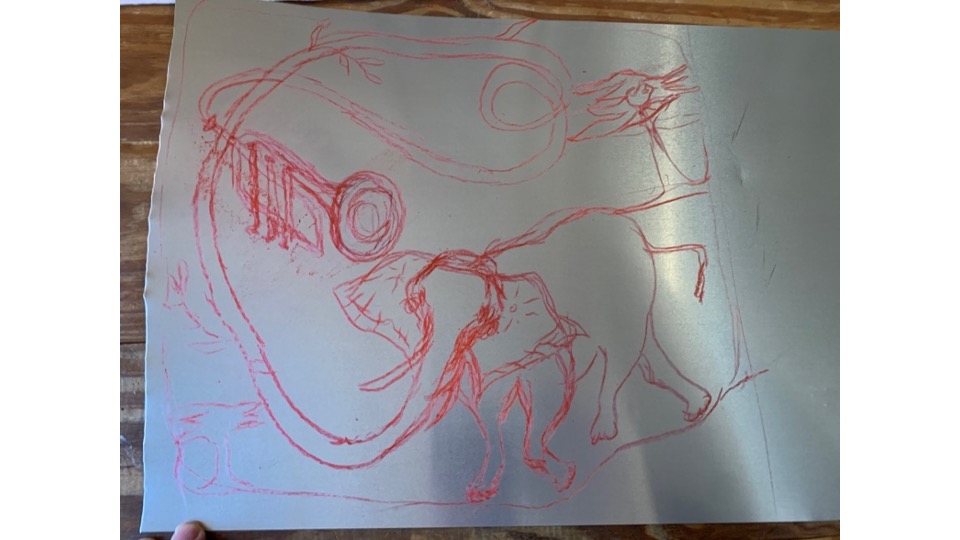
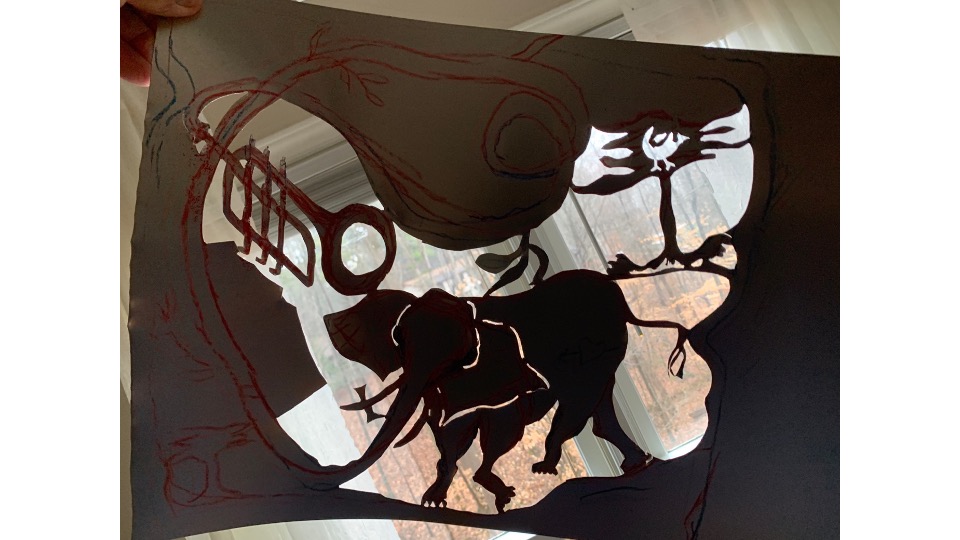
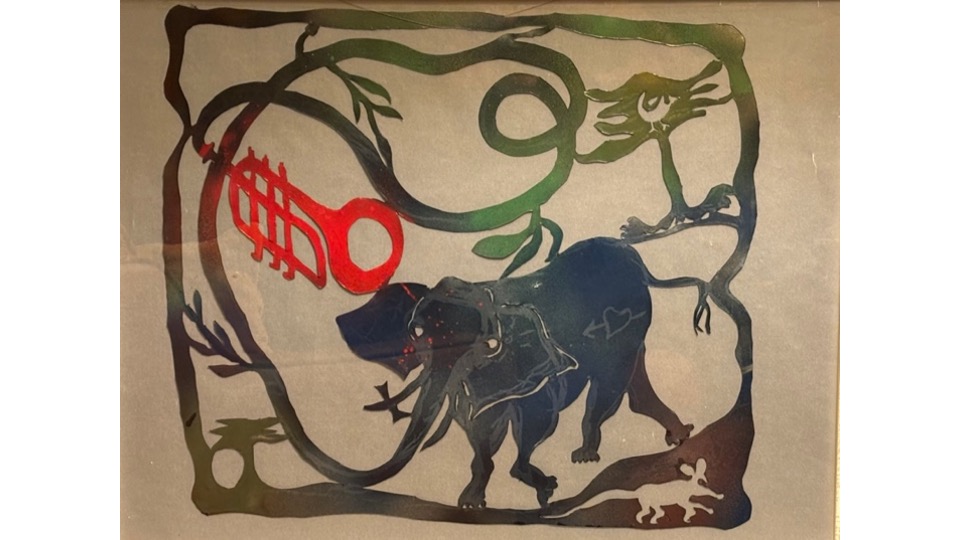
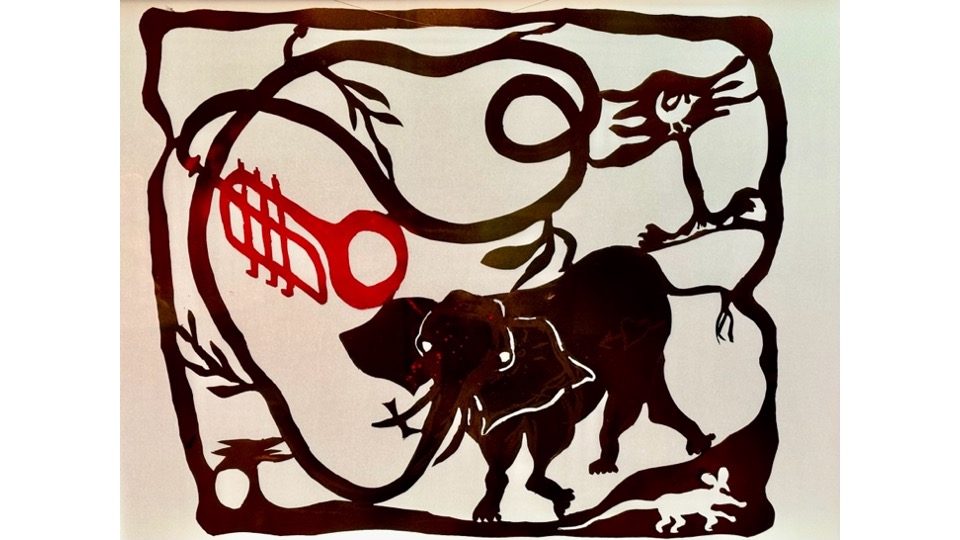
Leave a Reply